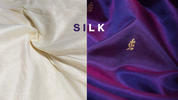
ما هو الفرق بين الحرير الخام والحرير الباناراسي؟
, بواسطة Regal Fabrics, 6 دقيقة من وقت القراءة

, بواسطة Regal Fabrics, 6 دقيقة من وقت القراءة
الحرير الخام: ألياف طبيعية غير لامعة. حرير باناراسي: فاخر، منسوج بتصاميم معقدة وخيوط ذهبية/فضية. أحدهما بسيط والآخر فخم.
في عالم المنسوجات اللامعة، لا يمكن إلا لعدد قليل جدًا من المواد أن تنافس الحرير. إنه نسيج مذهل. من بين أنواع الحرير، يبرز الحرير الخام والحرير الباناراسي باعتبارهما الأكثر شهرة. إنها مواد مميزة وثمينة ولكل منها قصتها الفريدة. ستناقش هذه المدونة الاختلافات بين هذين النوعين من أقمشة الحرير . ستناقش هذه التدوينة تاريخ إنتاجهما ومظهرهما وأهمية ثقافتهما.
الحرير، وهو ألياف تنتجها ديدان القز، كان محل تقدير منذ زمن طويل. يعود أصله إلى عصر الصين القديمة حوالي عام 2700 قبل الميلاد. وكان أول نبات يتم زراعته واستخدامه في الملابس الاحتفالية والملكية. كانت طريقة تربية دودة القز، التي تنطوي على تربية ديدان القز، ثم حصاد شرانقها، تعتبر سرًا. وقد أثرت بشكل كبير على التجارة والأزياء.
انتشر الحرير في أوروبا وخارجها عبر طريق الحرير. وكان رمزًا للأناقة والفخامة في العديد من الثقافات المختلفة. وقد جعله سطحه الناعم وبريقه الطبيعي المفضل لدى الأثرياء والملوك. ولا تزال شهرة أناقته مستمرة حتى يومنا هذا.

دودة القز هي مصدر الحرير، والحرير الخام ، والمعروف أيضًا باسم "الحرير البري" أو " حرير التوسا " هو نوع فريد من الحرير. إنه يختلف عن الحرير الذي ينمو، حيث تمضغ ديدان الحرير الخام مجموعة متنوعة من الأوراق وتمنح حريرها مظهرًا وشعورًا مميزين. الحرير الخام فريد من نوعه في الملمس والمظهر. إنه مختلف عن الحرير الأكثر نعومة والمزروع بشكل موحد. الحرير الخام فريد من نوعه في أسلوبه وسحره.
الحصاد: تقوم ديدان القز من البرية بغزل شرانقها في الغابات. يتم جمع الشرانق في الوقت الذي تخرج فيه العثات وبالتالي لا تتعرض ديدان القز للأذى.
إزالة الصمغ: يتم غمر شرانق الحرير في الماء الدافئ، ويتم ذلك لإزالة بروتين السيريسين، وهو المادة الرابطة لألياف الحرير.
اللف : تتم إزالة الألياف بعناية من الشرنقة. وعلى عكس الحرير المزروع، تتم إزالة ألياف طويلة. يتكون الحرير الخام من ألياف أقصر.
الغزل: يتم غزل الألياف الأقصر لصنع الغزل.
النسج: تحويل الغزل إلى قماش، عادة باليد أو باستخدام أنوال النسيج التقليدية.
يتمتع الحرير الخام بمظهر مميز يميزه عن أنواع الحرير الأخرى:
اللون: عادة ما يكون لونه بيج أو ذهبي فاتح بسبب العفص الموجود في الأوراق التي تستهلكها دودة القز.
الملمس: القماش خشن قليلاً مع عيوب واضحة.
الاعتبارات البيئية والأخلاقية
يُعتقد عمومًا أن الحرير الخام أكثر أخلاقية واستدامة بسبب مجموعة متنوعة من الأسباب:

يمكن وصف حرير باناراسي بأنه نسيج رائع ومعقد. وهو مصنوع من الحرير. وهو منتج من فاراناسي، مدينة أوتار براديش، الهند. وهو مشهور بتراثه الغني وتصميماته الجميلة واستخدام خيوط الفضة والذهب الأصلية.
معالجة الحرير: خيوط الحرير عالية الجودة والمزروعة تأتي من كارناتاكا والبنغال الغربية.
إنشاء التصميم: يستخدم الفنانون الخبراء ورق الرسم البياني لتصميم تصميمات معقدة مستوحاة من الطراز المغولي.
ثقب بطاقات الجاكار: يتم لصق التصميمات على بطاقات مثقبة ثم نسجها على نول الجاكار. وهذا يسمح بنسج أنماط معقدة.
الصباغة: يتم صبغ خيوط الحرير باستخدام ألوان زاهية باستخدام الأصباغ الاصطناعية والطبيعية.
صناعة الزاري: الزاري عبارة عن خيوط من الذهب أو الفضة، ويتم صناعته بلف أسلاك معدنية رفيعة بخيوط حريرية.
النسج: يستخدم النساجون النول اليدوي أو النول الآلي لنسج الأقمشة. كما يستخدمون النول الآلي لنسج الأنماط المعقدة.
اللمسات الأخيرة: يمر القماش بمعالجات نهائية لتحسين لمعانه وقوته.
يشتهر حرير باناراسي بمظهره الباهظ:
التصاميم: التصاميم الزهرية أو الورقية شائعة الاستخدام، وعادة ما يتم نسجها باستخدام قماش زاري فضي أو ذهبي.
الملمس : القماش ناعم للغاية وناعم. كما يتميز بثنيات سميكة وثقيلة.
اللمعان : يتمتع بلمسة نهائية شديدة اللمعان ويعكس الضوء، وخاصة حيث توجد الخيوط المعدنية.
يعد حرير باناراسي مكانًا ثمينًا في الثقافة الهندية:
الحرير الخام والحرير الباناراسي يمثلان اثنتين من أكثر التقنيات شعبية في صناعة الحرير. ولكل منهما خصائص مميزة. الحرير الخام، المشتق من ديدان القز البرية، له ملمس طبيعي غير متساو. له مظهر غير لامع أو منخفض اللمعان ومتوفر بدرجات ألوان ترابية. إنه أكثر بأسعار معقولة، وأخضر ويمكن استخدامه للملابس والديكور الداخلي. على النقيض من ذلك، يأتي حرير الباناراسي من ديدان القز التي تزرع في فاراناسي، الهند. يشتهر بسطحه الحريري وبريقه اللامع وتصميماته المعقدة. غالبًا ما تتضمن هذه التصميمات عمل زاري ذهبي أو فضي. يعتبر جزءًا مهمًا من الثقافة في الهند خاصة عندما يتعلق الأمر بفساتين الزفاف. إنه عنصر مكلف يأتي بتكاليف عالية. الحرير الخام سهل الصيانة ومن الأفضل استخدامه في الحياة اليومية. يتطلب حرير الباناراسي التعامل الدقيق وهو مناسب فقط للمناسبات الخاصة. عملية إنتاج الحرير الخام أقل تعقيدًا وتتطلب جهدًا أقل من الأيدي البشرية. ومع ذلك، يتطلب حرير الباناراسي إجراءً طويلاً ومكثفًا للعمالة. يتمتع كلا الحريرين بجاذبية فريدة. الحرير الخام والجميل هو الحرير المتين. حرير باناراسي فاخر وغني بتقاليد الثقافة.